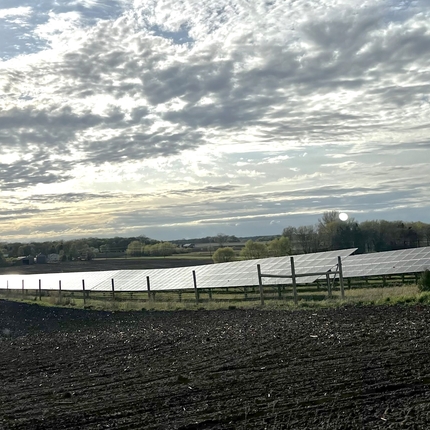Alex Delworth, policy associate, [email protected], 402.687.2100 ext. 1016 or Teresa Hoffman, senior communications associate, [email protected], 402.687.2100 ext. 1012
LYONS, NEBRASKA – As renewable energy development grows in rural areas, so do concerns about protecting agricultural land, especially from utility-scale solar projects.
The U.S. Department of Energy (DOE) estimates that by 2050 solar will occupy 10.3 million acres of land nationally, 90% of which will be in rural areas. To address concerns about utility-scale solar systems occupying a large amount of prime farmland, some local and state officials have proposed and even placed restrictions prohibiting it.
Alex Delworth, policy associate with the Center for Rural Affairs, said the restrictions are concerning.
“They can be debilitating for solar development, not to mention raise questions about private property rights,” he said. “In one instance, we found a county-level restriction related to prime farmland that eliminated 75% of potentially developable land in the area.”
While utility-scale solar projects can look intimidating amid concerns about taking land out of production, a new report from the Center for Rural Affairs found their overall impact on agricultural land use is minimal.
“Sifting through Solar: Land-Use Concerns on Prime Farmland,” written by Delworth, discusses how restrictions are designed and forecasts solar development’s impact on prime farmland in the Midwest region.
The DOE predicts that between 210 and 420 GWs of solar projects are needed in the Midwest by 2050 to meet federal decarbonization standards. According to the report, if all of the forecasted solar was built on the region’s prime farmland, it would occupy between 1.45% and 2.9%.
The report also addresses potential short-term impacts in Iowa and Minnesota.
Delworth said if every acre currently proposed for solar development in Iowa was built on the state’s top 14% rated farmland (90 Corn Suitability Rating, or CSR, and above), it would occupy 0.54% of the total acres. Furthermore, the proposed solar would occupy only 0.14% of the top 62% rated farmland (65 CSR and above).
The projected impact in Minnesota is also minimal. According to the report, if the number of acres currently proposed were located on prime farmland, it would cover less than 0.3% of the land.
Delworth hopes local, county, and state officials will consider the report’s findings as they decide the future of solar development in their area.
“Implementing rules that work with solar development rather than limiting it will open up economic opportunities for rural residents who want to voluntarily lease their land,” Delworth said. Renewable energy projects also generate tax revenue for counties, schools, and emergency services as well as create rural employment opportunities.
To read and download a copy of “Sifting through Solar: Land-Use Concerns on Prime Farmland,” visit cfra.org/sifting-through-solar.




